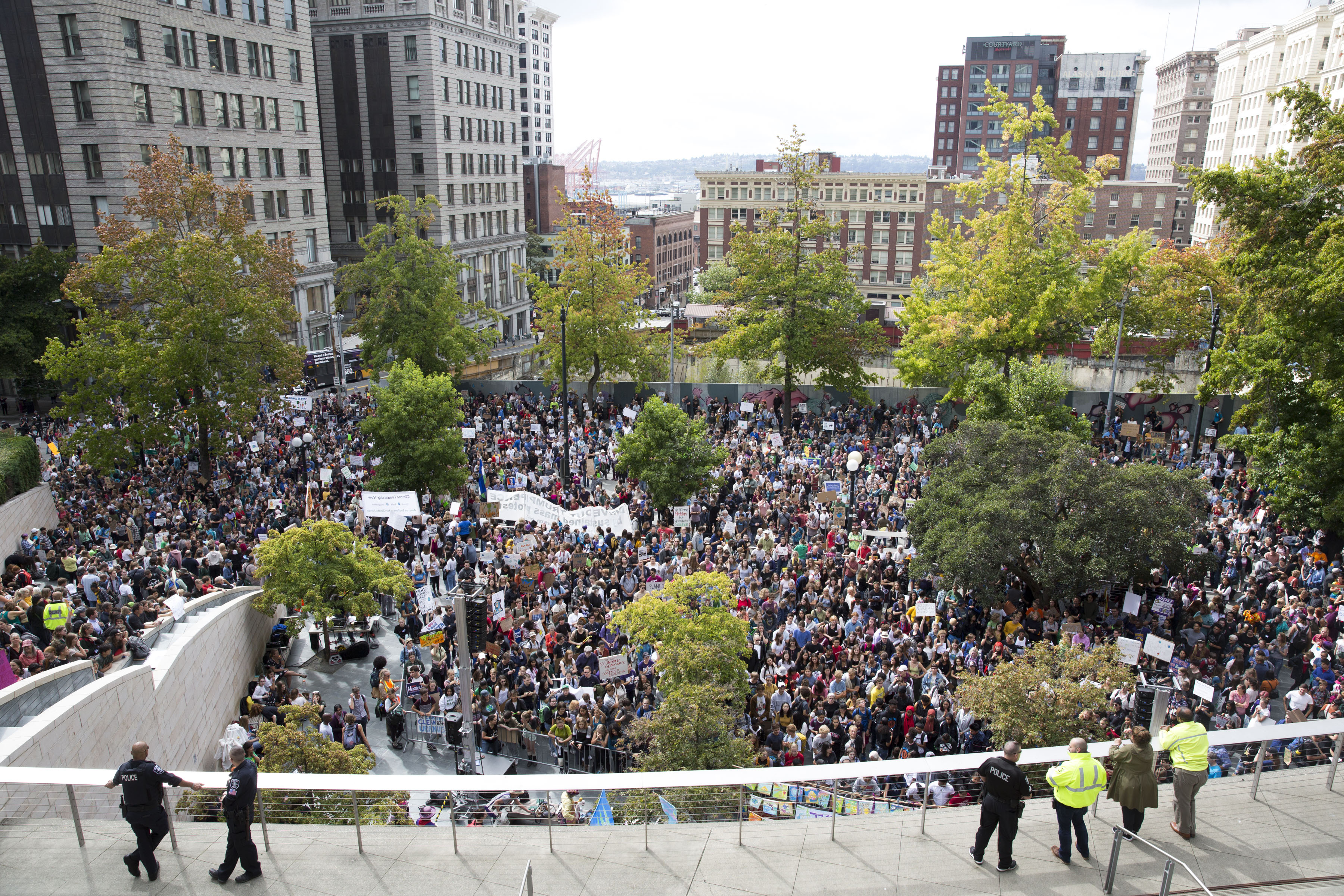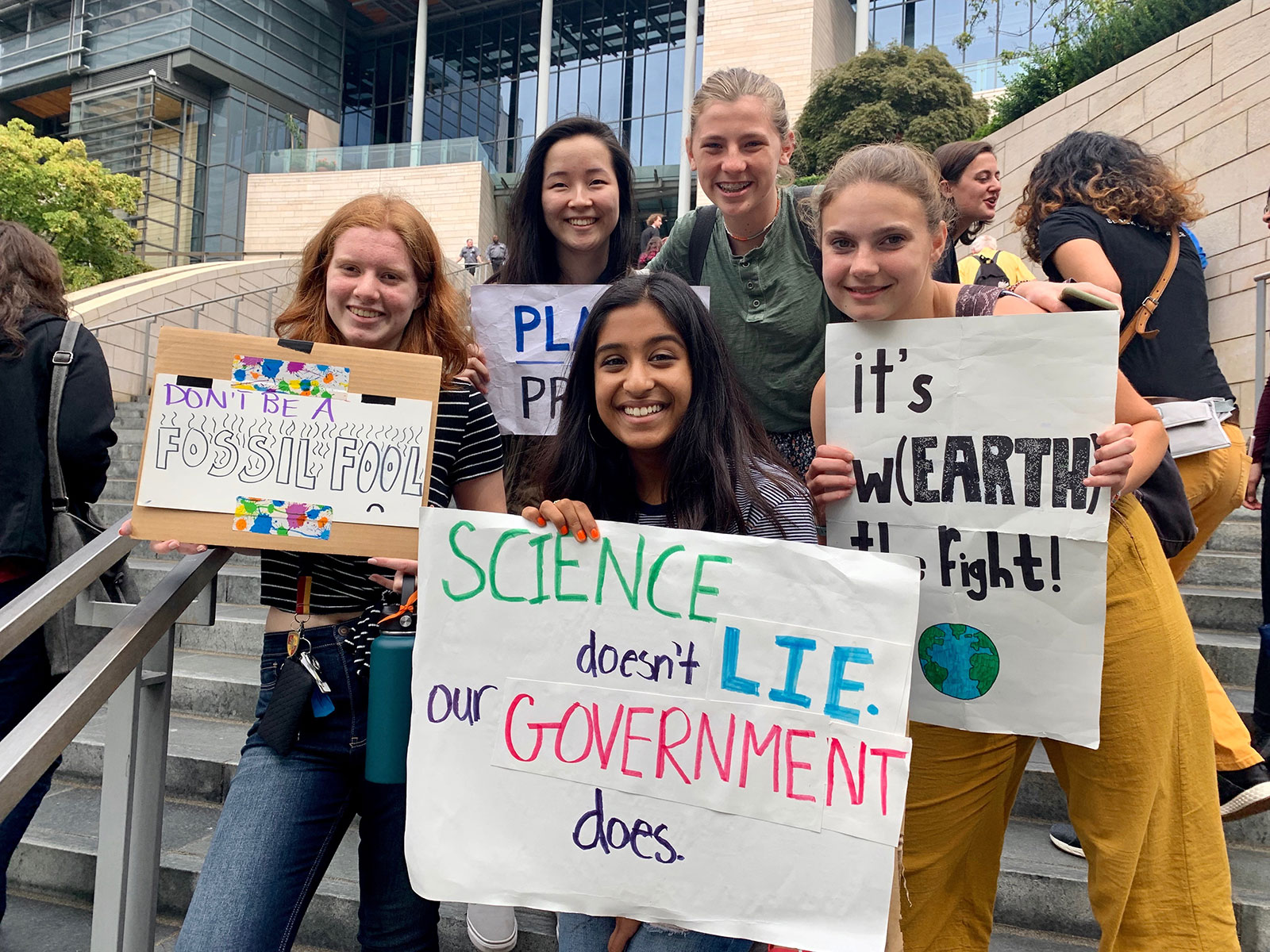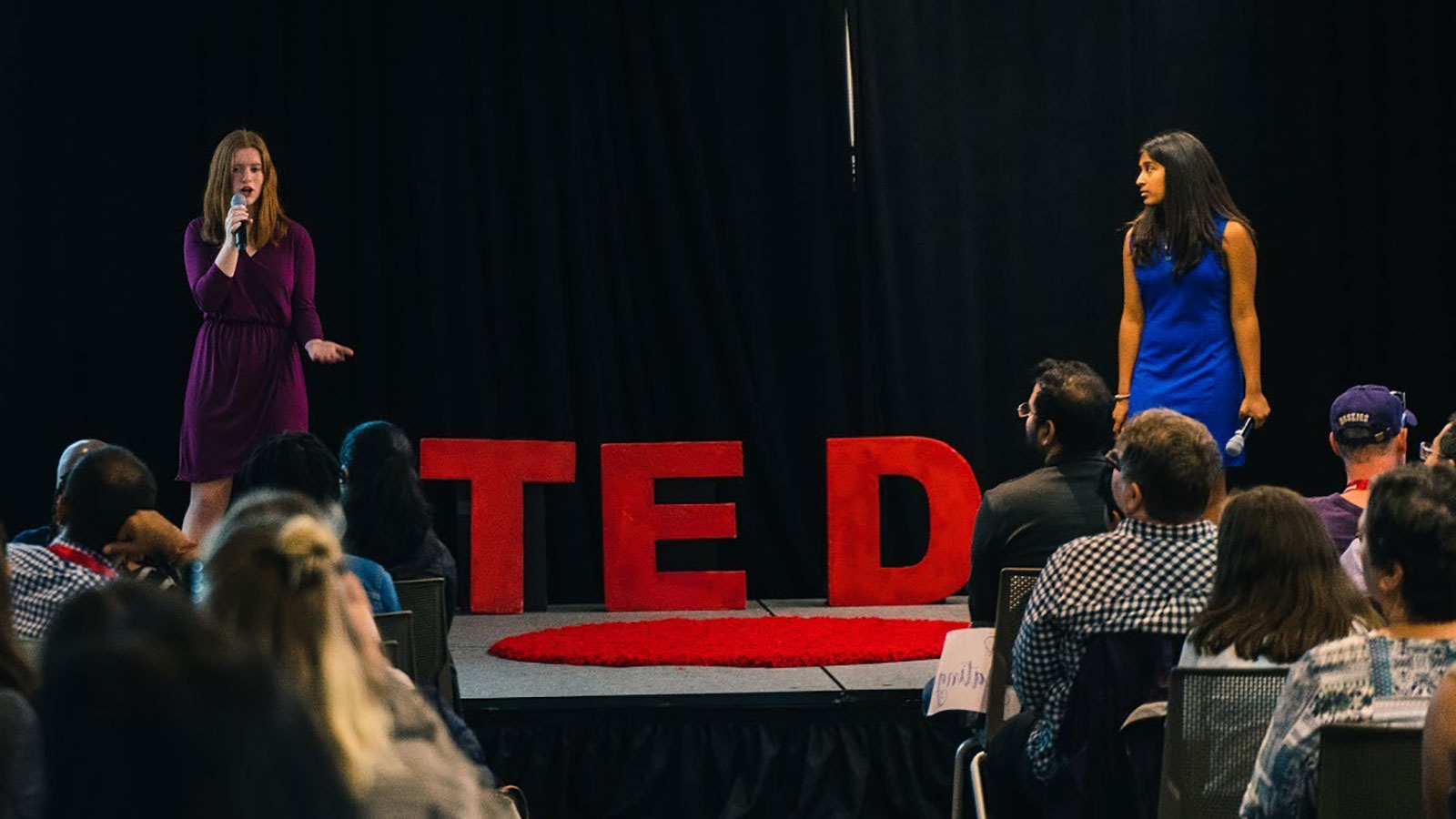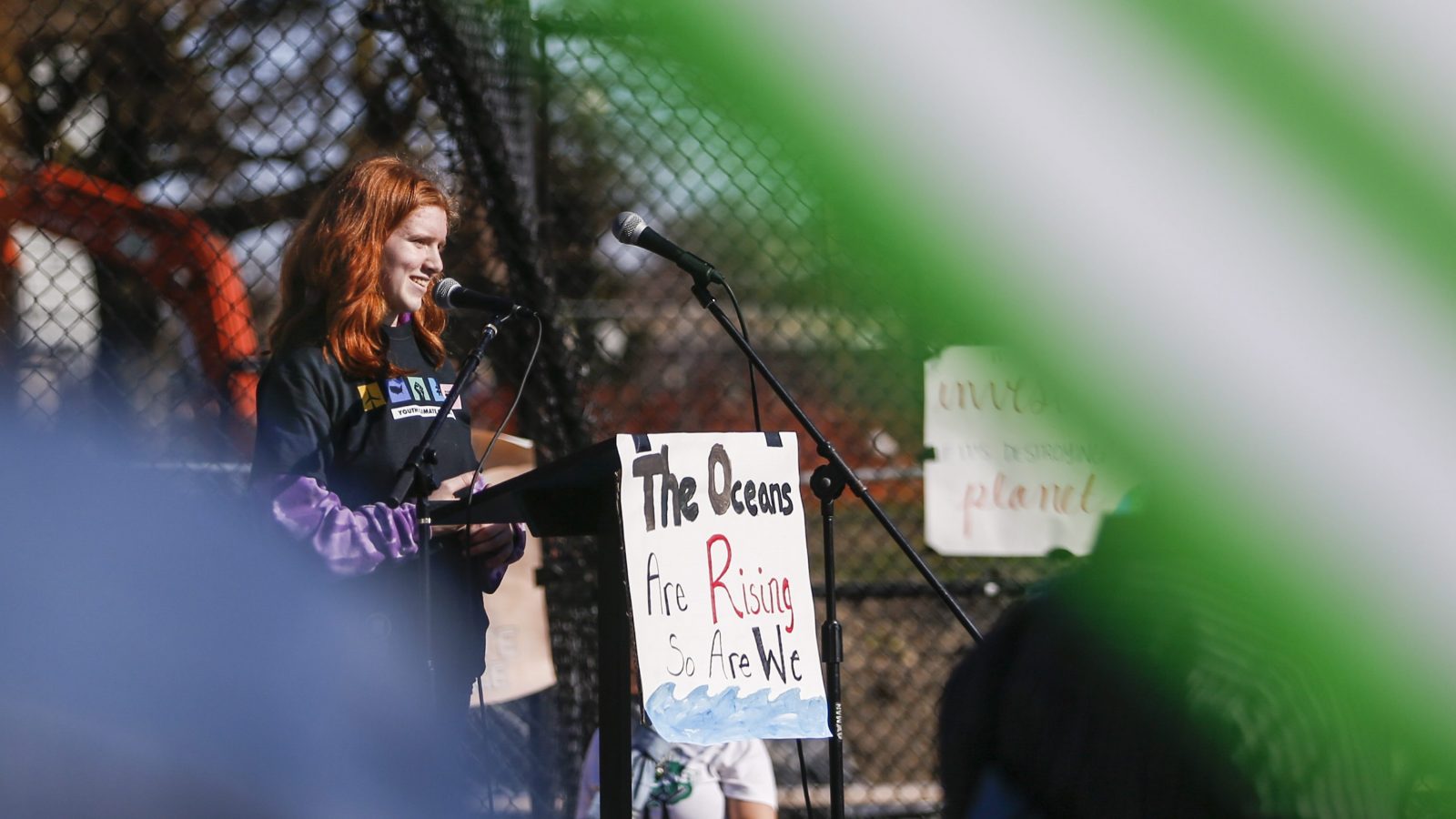The crowd was small, just a few hundred people, mostly high school- or college-aged. They milled around Lake Union Park, north of downtown Seattle, on a chilly, overcast Friday in December, holding signs with magic-marker drawings of the Earth in flames and slogans like “Climate Justice Now” and “Stop Burning Our Future.”
At 11 a.m., two high school sophomores with microphones climbed onto the rim of a broad fountain, drawing the crowd together and leading them out of the park. The rough column of people, chanting as they went, wound south through Amazon’s glassy office buildings and downtown high-rises to rally at City Hall as part of a nationwide Youth Climate Strike.
As the last stragglers trickled out of the park, a 17-year-old in jeans, sneakers, and a black Youth Strike T-shirt collected art supplies that had been provided for last-minute poster making. A high school senior with bright orange hair and an inexhaustible motor, Grace Lambert is co-executive director of Washington Youth Climate Strike, the group that organized the protest. This day was the culmination of months of hard work.
Earlier that morning, before the crowd gathered, I’d met up with Lambert at the park. Her first words, after the cursory “hello” and “how are you,” didn’t beat around the bush: “Event planning,” she said with a bright smile, “is really fucking hard.”
She wasn’t complaining — Lambert isn’t someone you’ll hear complaining much. From the beginning, the Washington chapter of Youth Climate Strike, like the broader youth climate movement, has insisted on doing it all themselves. They’re entirely youth-run and youth-led.
Over the many months I was in touch with Lambert for this story, I came to appreciate what an impressive feat these protests are, and the toll it takes on the high schoolers who have taken it upon themselves to push for action.
In that time, Lambert competed in the district swim championships (her team won first place), took the SAT, and started applying to colleges — all while managing a 90-person volunteer organization that staged two days of action in six cities across Washington. Lambert didn’t deny that juggling so many things could be stressful and exhausting, but she was always cheerfully on top of things during our conversations via phone, video call, text, and in-person.
Fast-forward a few months, and classes are taking place on the video conference platform Zoom. Thanks to the novel coronavirus, which arrived in Washington state seven weeks after the December Climate Strike, Lambert hasn’t seen her classmates — or any of her fellow organizers — in-person in nearly two months. The busy teen won’t have a senior prom or a traditional graduation ceremony. She’s decided to go to University of Redlands in California for college, but like many high school seniors, Lambert is now considering a gap year as COVID-19 disruptions might extend into the fall. “Everything’s a mess right now,” said Lambert. “I don’t want my freshman year of college to be like my senior year of high school.”
While everything else has been put on pause, Lambert and the rest of the Washington Youth Climate Strike team haven’t taken a break from organizing. They’re still meeting online every week, developing COVID-19-specific policy positions, and thinking about the best way to get their message out there. “We’re actually all doing more strike-related work, because we all have more free time and we kinda need something to distract ourselves, anyway,” she said. “To be honest, it was a lot easier for us in the climate movement to adjust than a lot of people. Like, all of our meetings take place via Zoom anyway.”
But in other ways, the game is totally different now. For the 50th anniversary of Earth Day, Lambert’s group was planning its biggest strike yet, complete with sit-ins. Instead, it will be hosting a series of workshop-style webinars as part of the 72-hour international Earth Day livestream. These “mobile-izations” — with titles like “Mutual Aid in the Time of Coronavirus and Climate Change” — will be focused on educating people about the climate crisis, organizing, and what they can do to help without taking to the streets, like contacting their elected representatives.
Youth climate organizers, many of them inspired by Swedish teenager Greta Thunberg, have faced all the usual questions that are leveled at social and political movements, especially youth movements: Is this generation really different than those that have come before? Do people who are too young to vote have the power to change the world? Ultimately, only time will tell. But the kids — and scientists — will tell you that the stakes have never been this high.
My own experience engaging with political issues as a teenager made me sensitive to just how demanding it can be. The more I saw of the passionate young people driving the youth climate movement, the more I wondered: Who does this, and why?
An activist is born
Lambert grew up in Mill Creek, Washington, a small town east of Seattle. Before taking up climate organizing, her days looked about like any other American teenager’s: swim practice, school work, hanging out with family and friends. Her high school civics teacher described her as a “fastidious student.” Sometimes she’d be on the set crew for school plays. On Sundays, there was church at the United Church of Christ, where her father is a pastor.
Politics were a popular conversation topic during family dinners while Lambert was growing up, but it wasn’t until the 2018 midterm elections that she got her first taste of hands-on political work. The whole family volunteered for now-Congressperson Kim Schrier’s campaign in Washington’s 8th District, which includes areas directly across Lake Washington from Seattle, as well as rural areas to the southeast. “It was awesome. I loved it,” Lambert told me when we met for coffee in November. She would head to the campaign office most evenings after swim practice to phone bank for a few hours before heading home to do her homework.

Lambert, center, celebrates with friends after an October 2019 swim meet. Courtesy Grace Lambert
I’m no stranger to phone banks myself, having grown up with a father who was deeply involved in Seattle and Washington state politics. In high school, I spent a lot of time in the campaign office when he was running for reelection as mayor of Seattle, and I confessed to Lambert that just the memory of cold-calling strangers still made me squirm. She nodded sympathetically before pointing out that it’s much easier than going door-to-door: “I actually thought phone banking was really fun, as annoying as talking on the phone is.”
It helped that the office where she volunteered was staffed primarily by young women who took Lambert and other younger volunteers under their wing, said Grace’s father, Ryan Lambert. “The fact that young people, young women, were helping lead in the office made a huge difference,” Ryan told me over the phone. “I think that it opened up her horizons to what’s possible.”
Not long after Schrier was sworn in to the most diverse, and most female, Congress in history, Lambert saw an Instagram post from the national group Youth Climate Strike about an upcoming day of action on March 15. “I was on their website one day and saw that they didn’t have contact info for anyone in Washington state, so I sent them an email to ask if there was a protest being planned anywhere near me,” she said. “And they said, ‘Nope — do you want to organize one?’ And I said, ‘OK.’”
To organize the first strike, Lambert enlisted her cousin, who had led a school walkout the year before as part of the March for Our Lives movement against gun violence. Still, a permitted march and protest were a larger undertaking, and there were many times in the five- or six-week leadup that Lambert doubted they’d be able to get everything together in time.
They pulled it off, with hundreds of people showing up for the Seattle protest. But shortly afterward, Lambert got some surprising news: This wasn’t a one-off project. The national and international chapters of Youth Climate Strike wanted to hold actions every few months, and the next one was scheduled for early May.
With help from Kimaya Mahajan, a high school sophomore Lambert met while planning the first strike, Lambert was able to get just over a hundred people out to another protest in May. Mahajan stayed on as the co-executive director of the Washington group, and the two brought more people into formal leadership roles.
“You can push school aside for five, six weeks,” Lambert explained. But that wouldn’t be sustainable if she wanted to keep organizing strikes. “It was like, how do I do all of this?”
In September, the group organized a third strike, bigger than any of their prior actions, drawing over 15,000 people in Seattle alone and thousands more in locations across the state. Lambert and her team had done their part to contribute to one of the largest days of global climate action in history.
‘Fake it ‘til you make it’
Lambert and I had our first conversation over the phone shortly after the September strike. We weren’t able to talk for long — her only window was during her lunch break. Being in class all day makes organizing extra challenging. It turns out most adults — including people from environmental groups, the media, permitting offices, and police forces — tend to conduct business during, well, business hours, and some are slower than others to get the memo to text or email instead of calling. (Things have of course changed over the past several weeks — with school canceled, Lambert’s schedule has opened up drastically. “It’s not like much else is going on.”
When I asked Lambert back in the fall if I could shadow her to see what it’s like to run a statewide climate action advocacy group, she said sure, any time — literally: The only day all fall that she wasn’t planning to do anything related to the strikes was the day of the district swim championship (where she’d compete in the 500-yard freestyle and 100-yard breaststroke).
In November, when we met in a café to talk about her earlier climate work, she was deep in the planning phase for the final strike of the year in downtown Seattle on December 6. “It’s a pretty fast turnaround from September,” Lambert said, explaining that strike dates were passed down to local chapters via the global team.
She appeared remarkably unfazed as we sipped our coffee. “It’s just not going to be as big as September — Kimaya and I, and a lot of our organizers, have had personal stuff come up.”

Students, tech workers, and others gather outside Seattle’s city hall for a rally during a climate walk out on September 20, 2019. Jason Redmond / AFP via Getty Images
Lambert also admitted that the organizers’ energy was low after the monumental effort that went into the September strike. “I wasn’t looking to get into this, at this level, at all, when I sent that email,” she said. “That’s how it is for a lot of us on our team, you kinda just fall into it.”
But Washington Youth Climate Strike’s continued growth showed that she had the attitude and grit to make things happen, and she’d learned some important things about managing self-doubt and nerves along the way. “Constantly with this work, you’re like, ‘Oh, I’m not good at this, Oh, I don’t know what I’m doing,’” Lambert told me. “ But what you have to realize is that no one knows what they’re doing. So fake it ‘til you make it. Just get it done.”
The only time her cheerful, matter-of-fact attitude wavered during our conversation was when I steered us toward the hypothetical day when the Grace Lamberts of the world could take a break from organizing protests and go back to being kids. She hesitated, not because she wasn’t ready with a vision of what success would look like. Here’s her vision: “A Green New Deal, basically, where there’s a set date where we’ll be at 100 percent clean energy and we’re actively ahead of that, people are actively transitioning, there’s been a culture change.” But her hesitation comes from her occasional struggle to believe that their movement will be able to overcome everything they’re up against.
“I’m hopeful and I’m not, it goes in spurts,” she said. “The day of the strikes, 100 percent. And then you get two months out from a strike and you’re like, ‘Ugh, we put so much of our time and energy into this and we haven’t really seen any changes.’
“It’s hard because I love this work, I love the people,” she continued. “But I wasn’t looking to take on this role, and shouldn’t have to be spending my time this way. None of us should. We should be able to be kids.”
When I pressed her on why she went to all the trouble — and why she continued to put in her time and energy even as more and more was asked of her — her answer was simple: If she didn’t, nothing would happen. “If I don’t do it, there’s not going to be a protest in my area,” she said.
A well-oiled machine
A few weeks later, I opened up my laptop to join one of the weekly video conference meetings with the Washington Youth Climate Strike leadership team — nine young women (including Lambert) who are responsible for different areas of operations.
After Lambert informed the group’s treasurer that an organizer in Bellingham, north of Seattle, had a finance request — “He sent me a Snapchat about it yesterday,” she said — each of the directors gave updates on their respective projects.
It was a perfectly professional meeting. It started on time. Lambert and Mahajan ticked through the items on the agenda they’d shared with the board before the call, wrapping up almost exactly on schedule half an hour later. The only reminder that this was a group of high schoolers was that everyone said “like” every third word.
Afterward, they figured out where everyone would be for the December 6 strike, now just a couple weeks away. Mahajan went over finances and upcoming strike dates, and said the executive directors would be having one-on-one meetings with everyone to set some longer-term goals for their role. Lambert was doing research on applying for nonprofit status.
I was impressed by how little of the call was spent on strike day logistics; clearly, everyone had received their marching orders for event-related tasks long ago and was taking care of them. Lambert told me later that throughout the week, she and Mahajan constantly texted with the other members of the leadership team as things came up.

Lambert, far left; Mahajan, foreground; and friends display their signs at a Fridays for Future sit-in in front of Seattle City Hall in August 2019. Courtesy Grace Lambert
I stayed on the call to chat with Lambert for a few minutes after everyone else had signed off. “How’re you feeling?” I asked, only to be interrupted by a call from her co-lead, Mahajan.
“Sorry! I’m good, just exhausted right now,” said Lambert, sending Mahajan to voicemail. The two of them had chatted before the meeting and still had more to discuss that night. “We talk pretty much every day —no way I could do this without her,” Lambert told me. It was getting close to 10 p.m., so I signed off to let her get to it.
A week later, the Sunday after Thanksgiving, I caught up with Lambert again in east Seattle. In a small, brightly lit room in the Montlake Public Library, 10 high school-aged women sat in a circle around two tables covered in paints, markers, and pieces of poster paper and cardboard. They decorated pieces of cardboard with slogans like “There is no planet B” and “Hotter than I should be” for the December 6 strike, less than a week away.
As I listened to the assembled activists chat about their holidays and classes, I realized that they all went to different high schools. When I asked how they’d gotten together, most had the same answer: They met on Instagram.
I felt a little bit like I was back at a meeting for a high school club, and not just because of the number of the people in the room wearing braces. There’s a specific energy when a bunch of friendly young people who don’t necessarily hang out in their free time come together over a shared cause. Near-ubiquitous smartphone ownership and unmatched social media fluency may have let Generation Z organize on a scale that their parents could never achieve with flyers and word-of-mouth, but high schoolers’ small talk is about the same as it always was.
Lambert was in the corner with her laptop open in a sweatshirt and leggings. She was upbeat, as always, but by now I knew her work wasn’t as easy as she makes it look.
“It’s hard to live with a crisis over your head at all times,” her father, Ryan, told me over the phone in November. Sometimes he and his wife felt like they needed to step in when their daughter seemed worn down. “It’s emotional work she’s doing, it’s exhausting work she’s doing, it’s demanding work she’s doing. Sometimes we have to tell her, ‘No, you can’t go for 23 hours without sleeping,’ or ‘You can’t be at everything, you still have to rest.’”
Another big day
The turnout in December was nothing compared to the masses at the September 20 strike, with just 4,000 or 5,000 people spread out at six strikes across the state, but the crowd that filed out of Lake Union Park bound for City Hall was still impressive — and the silence that followed their departure was palpable. A man in a Seahawks hat walking his dog was the lone occupant of the grassy part of the park that had been swarming with protesters just a half hour earlier.
Lambert and I got the last box of supplies into the trunk of her car right as raindrops started to fall, and I gratefully accepted Lambert’s offer of a lift to City Hall. While she navigated midday traffic, I asked what she’d be up to that weekend, after the strike. Would she and the team have some sort of celebratory gathering? Or at the very least some time off? You’d think, by this point, that I’d have known better.
“I wish,” Lambert told me. “Tonight, I’ve got to write an English paper that was actually due in class today — good thing I wasn’t there.” And after that? “Tomorrow or Sunday, Kimaya and I will send out an internal survey to all of our organizers, to get responses on what went well and what didn’t so that we can start thinking about what to do differently next time.”
But there was some good old-fashioned teenage fun on the schedule, too: She had tickets for pop artist Conan Gray’s concert on Saturday night. “It’s better than the weekend after the September 20 strike,” she laughed. “Kimaya and I had to give a TED Talk on Saturday morning. It was terrible timing. I think I’d gotten, like, four hours of sleep a night that whole week.”

Lambert, left, and Mahajan speak about their experiences organizing climate actions at the TEDxRedmond event this past fall. Courtesy Grace Lambert
I was struck by the matter-of-fact way Lambert reeled off everything she needed to do in the coming weeks for the next strike, even as we were literally in the middle of an action she’d been planning for months. (That next strike, scheduled for April 22, was canceled when Washington Governor Jay Inslee issued a stay-at-home order in March to slow the spread of the novel coronavirus.) On one hand, it shows the degree of professionalism and sophistication that a group of volunteer high schoolers had achieved less than a year after Lambert started the state chapter. Enough other people were involved and could take care of various day-of tasks, so Lambert, as co-executive director, could focus on long-term strategy.
But it was that very adult-like organizational sophistication that felt so wrong. A constant stream of more work to be done is, of course, how it is to have a job or take care of a family. But are high schoolers supposed to be in it this deep?
Lambert wasn’t really getting caught up in whether or not it was “right” that she was spending her last months of high school trying to solve a problem that wasn’t her fault to begin with. “If we only have the adults organizing then that’s not taking us into account, and it’s our futures that are on the line,” she pointed out. “It shouldn’t be our job, but at this point, it kind of has to be.”
We parked the car a few blocks from City Hall in time to catch the tail end of the march. Lambert immediately fell in next to someone she knew. I drifted back a few paces to take in the scene. But for the glint of her bright orange hair, Lambert was nearly impossible to pick out from the rest of the crowd.
How much of this would have happened, if not for Lambert? It’s impossible to say. I suppose it’s pointless to try quantifying the significance of one individual to this global movement — over these last few months, it’s been clear that Lambert is only one of many passionate climate activists willing to make sacrifices for her cause.
And she’s determined not to let the COVID-19 pandemic stand in her way. Lambert plans to keep the heat on political leaders to take action on climate change, telling me last week that if anything, the outbreak has only emphasized the urgency of the young activists’ cause. ““The climate crisis is going to make things like this worse and happen more often,” Lambert said.
She was remarkably upbeat about the adjustments her team has had to make on the fly — including the group’s totally re-envisioned Earth Day action. “It’s a chance to show people, ‘Hey, the climate crisis is a multifaceted issue, and we care about more than the fact that the earth is warming,’” she said. “We’re going to use [this change in plans] to the best of our ability and try to grow our platform from it.”




